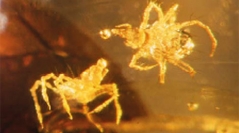

 Comptes Rendus Palevol
6 (1-2) - Pages 151-156
Comptes Rendus Palevol
6 (1-2) - Pages 151-156The amber is a fossilized vegetal resin ranging from a few millions to more than 300 million years in age. It constitutes a superb material for the conservation of biological inclusions in their minute three-dimensional details. This material not only preserves life forms, but also some aspects of their mode of life and their ecology such as swarming or mating, all kind of symbiotic associations like commensalism, mutualism, and parasitism. This paper deals with the aspects of preservation and accumulation of biological inclusions and their significance in the Lebanese amber.
Lebanon, amber, fossil insects, palaeoenvironment, palaeosymbiosis, palaeoparasitism, palaeobiogeography